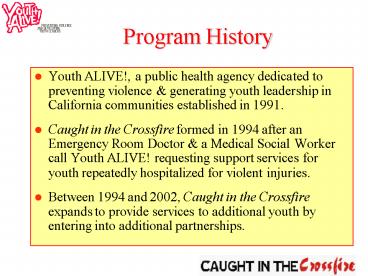Program History PowerPoint PPT Presentation
1 / 25
Title: Program History
1
Program History
- Youth ALIVE!, a public health agency dedicated to
preventing violence generating youth leadership
in California communities established in 1991. - Caught in the Crossfire formed in 1994 after an
Emergency Room Doctor a Medical Social Worker
call Youth ALIVE! requesting support services for
youth repeatedly hospitalized for violent
injuries. - Between 1994 and 2002, Caught in the Crossfire
expands to provide services to additional youth
by entering into additional partnerships.
2
Partnership with ACPHD
- Since 2001
- Planning meetings with Jeff, Kimi Medical
Directors - Current partnership with Tiger Health Clinic/La
Clinica - Public Health Nurse provides services to clients
3
Demonstration of Need
- 113 homicides in Oakland in 2002!
- Of 113 homicide victims, 42 were age 25 or under
- Of known homicide suspects, 50 were age 25 or
under - Guns were the mechanism of injury in 85 of these
homicides (99 for victims 25 and under)
4
Program Goals
- Prevent retaliatory violence.
- Reduce total number of youth injured killed by
interpersonal violence. - Reduce entry re-entry into the criminal justice
system. - Promote positive alternatives for youth.
- Provide positive peer role models.
5
Program Overview
- Employs local community residents who have
experienced overcome violence in their own
lives to serve as Intervention Specialists (IS) - Intervention Specialists act as mentors provide
case management, support wraparound services
to clients and their families
6
Client Population
- Youth ages 12-20 injured by interpersonal
violence - Middle high school students ages 11-18
identified as being at high risk for dropout,
suspension or violence - Program participants families and friends
7
What A Patient Can Expect After Hospital
Discharge For
- Heart Attack
- Diet plan
- Exercise plan
- Stress reduction plan
- Gunshot Wound
- Painkillers (1 week supply)
- Bandages
8
Risk Factors for Youth Survivors of Violence
- Youth are discharged from hospitals into the same
violent environment in which they were originally
injured. - Family and friends may want to retaliate on
youths behalf as a show of support.
9
Program Services
- Intensive initial bedside/home visit
- Case management/mentoring involving ongoing
intensive personal telephone contact for up to
one year - Information and referrals
- Advocacy for youth and their families
- On call 24/7 crisis assistance and support
10
Services Referrals
Youth family
School
Hospital
Caught in the Crossfire
Health Care
Emergency Services
Job Training Placement
Counseling Services
School Enrollment
Court Advocacy
Transportation
Educational Programs
11
Fiscal Cost Comparisons
- Total program cost per year is approximately
300,000 (averages to 3,000 per client per year) - Costs of other programs/alternatives per person
- 27,000 for California Youth Authority per youth
per year - 40,000 for gun shot treatment per patient
(Rizer et al. Hospitalization charges, costs, and
income for firearm-related injuries at a
univiersity trauma center. JAMA. June
14,1995273(22)1768-1773.)
12
Case Study
- Name Maurice
- Age 15 years old
- Injury Gunshot wound to hand gunshot wound to
face 3 weeks later
13
Program Evaluation
- A non-randomized retrospective case control study
of the hospital component of the program was
conducted from 1998-2001 by a multi-disciplinary
evaluation team - The California Wellness Foundation Violence
Prevention Fellows - Highland Hospital Trauma Services/ UC Davis
- Community Epidemiologist (Alameda County Public
Health Department) - Youth ALIVE!
14
Evaluation Design
- Total Sample Size112
- Treatment Group (N43)
- Youth ages 12 through 20 treated for
violence-related injury at Highland Hospital
1/1/99-5/31/00 who had 3 contacts with an IS
within 6 months of hospital release (at least 1
in-person contact) - Comparison Group (N69)
- Youth ages 12 through 20 treated for
violence-related injury surviving at Highland
Hospital 1/1/98-12/31/98 who did not receive any
program services - Data collection period6 months following date
of injury
15
Demographics (Treatment Control)
61
24
8
6
- 79 male 21 female
- Average Age 18 years
16
Key Outcomes Evaluated
- Rate of entry/re-entry into criminal justice
system - Rate of re-injury/ re-hospitalization
- Rate of violence-related death
17
Data Collection Methods
- Record review from the following data sources
- Highland Hospital, Eden Hospital, Childrens
Hospital Oakland - Alameda County Coroners Office
- Alameda County Probation Department
- Oakland Police Department
- Client case notes
18
Results
- Significantly lower arrest rates during 6 months
post-injury among treatment vs. control - One re-injury among treatment group during 6
months post-injury one re-injury among control
group - No violence-related deaths among treatment or
control group
19
Arrest Rates Prior to Injury
53.5
52.2
34.9
26.5
20
Arrest Rates During 6 Months Post-Injury
15.9
5.8
4.7
0
p
21
Reduction in Arrests
- Intervention youth were 70 less likely to be
arrested for any offense (odds ratio0.257) and
60 less likely to have any criminal involvement
(odds ratio0.356) when compared to controls. - Defined as placement on/violation of probation
or arrest
22
Linkage Between Arrests Health
- Criminal involvement places an individual at
increased risk for subsequent violent
victimization. - Dobrin, AL. The risk of offending on homicide
victimization A case control study. Journal of
Research in Crime and Delinquency
200138(2)154-73. - Dobrin, AL. The risk of offending on homicide
victimization A public health concern. Am J
Health Behav (forthcoming).
23
Study Limitations
- No long-term follow-up
- Results may have been confounded by historical
effects - Key indicators (school enrollment employment)
not measured in relation to need data not
available for control group
24
Program Outcomes
- Provide positive role modeling, mentoring, and
advocacy for youth and their families - Provide case management and wrap-around
services to youth and their families - Empower community members to improve their
communities by hiring training them to serve as
Intervention Specialists
25
Program Outcomes
- Provide trained peer bedside visitation and home
support to youth and their families - Provide youth with alternatives to violence
- Connect youth with community resources

